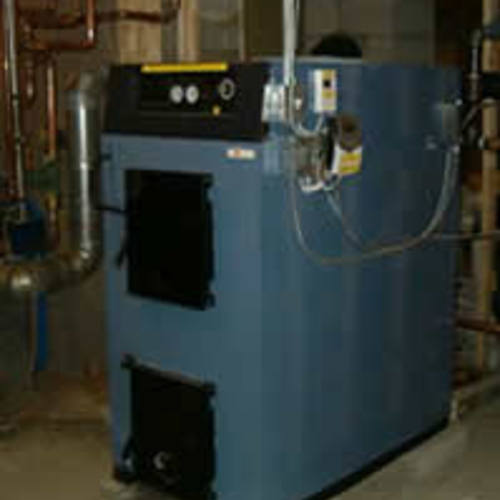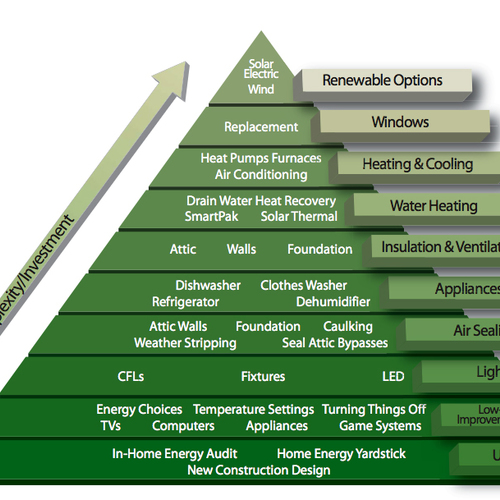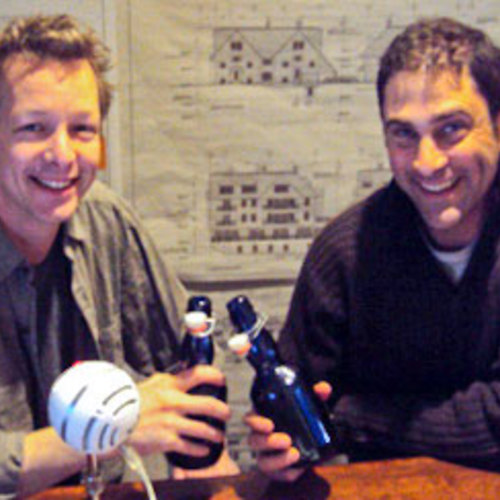
*2 parts Red Stag Bourbon (by Jim Beam)
*1/2 part Sweet Vermouth
*1/2 part Dry Vermouth
*2 dashes of Angostura bitters
Shake with ice in cocktail shaker, and serve. Garnish with fresh pitted (or half) cherry.
For this Green Architects’ Lounge podcast, we are joined once again by our good friend Pat Coon, from Revision Heat, to discuss the topic of biomass boilers—both gasification log boilers and wood pellet boilers. As we did with the Deep Energy Retrofit episode, we’ve divided the original recording into three blog-size pieces that are better suited for this format.
When we recorded this, the BP Deep Horizon well was spewing 20,000 barrels of oil into the Gulf of Mexico every day, after killing 17 people in a massive explosion. This was right on the heels of Massey’s Big Branch Mine disaster that claimed 28 lives. We thought it apropos to discuss an immediately available alternative fuel source that often does not get the consideration it deserves.
In Part One of the podcast, we start with gasification log boilers, and discuss:
- Is burning wood green? (Particulate matter, carbon cycle, sulfate and nitrate output, and how your wood is harvested)
- When should you consider wood as a fuel source?
- Gasification—it’s burning the wood. And the smoke.
- How often do you need to load wood?
- Do you need thermal storage?
- Does the unit need makeup air?
- The quality of fuel and its output.
I should also mention that Phil and I trade roles for this episode. He mixed us the cocktails, and I got to choose the song, “Daydreamer” by Pete Miller. Stay tuned for Parts Two and Three, where we’ll talk about wood pellet boilers, compare them with log boilers and talk about cost.
Enjoy the show.
OFFICIAL TRANSCRIPT
Chris Briley: Hey everybody, welcome to the Green Architects’ Lounge podcast. I’m Chris Briley.
Phil Kaplan: And I’m host Phil Kaplan.
Chris: How you doin’, Phil?
Phil: I’m doin’ great, Chris. We’re also very excited to have Pat Coon.
Chris: Hey, Pat! Welcome back.
Phil: You remember Pat from a podcast or two ago.
Chris: Right, solar thermal podcast. Which was well received. So, thank you for your efforts there. Hopefully, this one will be equally as good…
Pat Coon: Or better.
Phil: Better, I’m sure. Judging by these drinks, it might be!
Pat: What are these, by the way?
Phil: I’m glad you asked.
Chris: Very good segue. Go, Phil.
Phil: Today, I get the drink. Chris and I are switching this time.
Chris: It’s like the “bizarro” episode.
Phil: Backwards world.
Chris: Phil’s got the drink. Whaddya got? Go, buddy.
Phil: And Chris has the music. We are drinking Perfect Red Manhattans. What do you think?
Chris: Very good. Usually, I think vermouth and bourbon have no business being together, but you have proven me wrong.
Phil: Ah, they’re good friends, Chris. I just have to introduce them properly.
Chris: I guess so. I guess tossing them in a trash bag and tossing them around and chugging it with a bunch of friends is not—I’ve never really done that, Mom.
Phil: So, can I tell you what’s in it?
Chris: Please do.
Phil: All right, so the key ingredient to a Perfect Red is Red Stag. It’s black cherry infused bourbon.
Pat: Oh, it’s good—you can taste it.
Phil: So, it takes the typical cherry that usually sits in a Manhattan and gives it a little oomph. You add two parts that, and you add half part sweet vermouth, a half part dry vermouth, and a couple little dashes of tasty bitters. In summary: Tasty, and it does pack a punch.
Chris: We’re going to have to pace ourselves.
Pat: Didn’t our generation decide not to mix drinks? I thought we figured out that we’re going to be beer, and maybe a little wine.
Chris: I think that’s all changing. I heard that in Germany, beer is no longer number one.
Phil: You know what’s interesting? Chris, for all the weeks he’s been doing the drink, he did not have his own Mr. Boston. And this week, courtesy of Green Building Advisor, a little present came in the mail…
Chris: My own—our own copy of Mr. Boston’s Official Bartenders Guide.
Phil: The Perfect Red is not in there, by the way.
Chris: I know. I looked. So, thank you, Green Building Advisor. They said it was for our “research.” I will be researching many things.
Phil: So, again, Pat’s company is Revision Heat. They’re out of Portland, Maine.
Pat: And Brewer, into Bangor.
Chris: And today we’re going to be talking about biomass boilers—both gasification log boilers and pellet boilers. And I think it’s noteworthy that while we’re doing this, there’s like 15,000 gallons of oil a day popping into our Gulf. Have you heard about this? The leak?
Phil: Yes, as a matter of fact, I have.
Chris: Anyway, there’s never been a more poignant point, where we’ve got people dying from coal mine disasters, people dying from oil disasters, and all of our coasts in jeopardy, and mass hysteria out there.
Pat: And we’re going to talk about whether wood is an environmentally sustainable option. That’s a question written down here.
Chris: Oh, we have notes!
Phil: We were saying, we’re getting drilling back to the land.
Chris: So, Pat, is it green?
Pat: Can we just skip the question and move on?
Chris and Phil: Yes!
Chris: Otherwise, we probably wouldn’t be talking about it. But let’s just make the argument…
Pat: I say that facetiously, because it is a valid question and people think about it. The things to think about when you’re thinking of burning wood are particulate matter, carbon cycle, and—something else that I can’t remember. Oh yeah, nitrates and sulfates. So, in terms of particulate matter, high-efficiency European gasification technology—the good boilers and the good stoves—bring particulate matter down to a level that’s going to be higher than oil and much higher than gas boilers, but still well within any tolerable levels.
Chris: So, the reason we’re even considering wood now—for some people, that does not even spring to the forefront of their mind: “I’m going to heat my house with wood.” They imagine shoveling logs into a fireplace or woodstove. But we’re talking about something different. We’re talking about a big box in the basement that we’re going to feed a fuel, we’re going to have distribution, and heat the house.
Pat: Yeah, and that technology is very different from fireplaces—and even the woodstoves of the pre-EPA era. Particulate matter is what causes asthma. High-efficiency wood boilers are going to be just slightly higher emissions than their fossil fuel counterparts, so they lose in that category. But they crush fossil fuels in the carbon category—anywhere from 1/10 to 1/100 the carbon input compared to fossil fuels, depending on how you get your wood. You can go out to the back of your woods with a wheelbarrow and a handsaw, and you have no carbon footprint at all. Or you could get it commercially harvested, and you would have 1/20 the carbon dioxide output per unit of fuel. And the other category is sulfates and nitrates. Those are the things that cause acid rain. And burning wood has virtually no sulfuric and nitric emissions. So, in two of the three categories, wood crushes fossil fuel environmentally. The other thing we can ask ourselves is the long-term health of the forest. And it depends on where you are, is the answer, and who’s harvesting your wood. In Maine, about 90 percent of the wood that’s harvested now is harvested from some sort of sustainably managed…—with sustainable credentials.
Chris: Right. And we have largely the paper companies to thank for that.
Pat: Yeah, FSC certification and Master Logger certification. So, there are people looking at how the wood is being harvested.
Chris: This is a great state for this.
Phil: It is! And my question for Pat is: Is it fair to say the region where you live depends on whether or not this makes sense?
Pat: I’d even say, more than that, it’s right down to the house. It really depends on how you’re harvesting your wood. And if you’ve got woodland behind your house, it doesn’t matter if the county is devastating its woodlot if you’re sustainably managing your woodlot; then it’s a sustainable solution.
Phil: But if you’re in an urban setting, it’s a different story.
Pat: Yeah, but I would say it depends on where. We have downtown Portland, 30 miles away, we’ve got plenty of firewood.
Chris: OK, so if I, as an architect—if a client comes to me, and we have that conversation where we’re talking about systems—what are the things that should trigger me into saying, “You know, we should look into wood boilers”? Granted, you’re a little biased.
Pat: All the time…
Chris: No, but seriously, there are some cases—there are some perfect houses where this is perfect for them.
Pat: Wood is so easy, because it all comes down to how much wood you want to schlep. As an architect, if you can work people through the quick and dirty energy demand—so you’re going to build conventionally, you might be at 50,000 Btu per square foot per year. So that would be like two cords of wood per 1,000 square feet per year.
Chris: Using a boiler?
Pat: Using a high-efficiency boiler. If you’re going to build a 6000-square-foot house and build it conventionally, you’re going to be schlepping 12 cords of wood. Simple question: Do you want to be schlepping 12 cords of wood? For most people, that’s going to be no. For other people, “Oh yeah, that’s no problem.” So, then, as the architect you can say, “How about a 3,000-square-foot house, and we can superinsulate it and use R-60 walls, and put a heat pump on it?” That’s one option. But what about a 2,000-square-foot house that’s modestly insulated that uses three cords of wood a year? That’s in a range where wood boilers don’t make a lot of sense in a really, really well-insulated house that you guys build a lot of, because there’s just too many mechanical systems for the amount of energy.
Chris: And a lot of mass.
Pat: And a big space in the basement.
Chris: Right. So, it’s good for mid-range houses, then? In terms of energy consumption and size…
Pat: Decently insulated… When I talk to people about wood boilers, I say, “Look, if you’re thinking about putting in a wood boiler, think about not putting in an HRV.” Don’t hit me for that.
Phil: This is a very interesting conversation. The metrics Chris and I have talked about in some of our episodes—you do certain things, you add more insulation. The reality is, if you have 2×6 walls with cellulose insulation, that might be OK if you’ve got tons of wood in the backyard. Why spend the extra money in this case, if you don’t mind the schlep?
Pat: Right. You take that 2,000-square-foot house, and you go from OK insulation to really well insulated, you’re talking about four cords down to two cords. Four cords is not a whole lot of wood. It really is an interesting conversation to have because—four cords, you would need four acres of good forest to support that house, sustainably and forever, in Maine. That, to me, is not a bad solution.
Phil: Is that a one-to-one rule of thumb metric? Four cords, you need four acres?
Pat: It’s a half cord to one cord—and that depends on soil type. If you have a swamp, then you can produce half a cord forever out of your swamp.
Phil: OK, so if we talk about doing this sustainably, then we ask the client, “How much wood do you have?” Or how much land do you have? I think that’s a very helpful metric, because we’ve talked about rules of thumb that help our listeners.
Chris: Just a little trivia: Back when we were England here in Maine, it used to be that you’d get 10-acre parcels because that’s what was deemed sustainable. You could have a small farm, small livestock, small woodlot. Ten acres, off you go. But anyway, this technology is perfect for the same kind of mindset, in my own opinion. So, Pat, this is not just throwing wood on a fire. This is a gasification wood boiler. This is a different kind of technology. So, first let’s talk about what is gasification, and how is this boiler different.
Phil: What does it look like, where does it sit—the physical stats.
Pat: Imagine you’re a particle of smoke; you’ve just been liberated from the wood.
Phil: Anyone see “Lost”? Black smoke? That’s all I’m saying.
Pat: So, you’re in a fireplace. You’re a particle of smoke. The heat has just liberated you. If you mix with oxygen and enough heat, you will convert yourself into carbon dioxide and water…carbon monoxide…one of those carbons and water. You will turn yourself into heat. Your bonds will be broken, and you’ll create heat. You have to bump into just the right amount of oxygen, and just the right amount of heat, to make that chemical reaction happen.
If you’re in a woodstove, without a catalyst and no real good air control, there’s a 50/50 — a pretty marginal chance that’s going to happen. And if it doesn’t happen, then you go out the chimney as smoke and you never get that heat translated.
It turns out that wood is a hard thing to burn because of that. And it also turns out that smoke is a pretty easy thing to burn. So what gasifying boilers do is take that smoke and treat that as the fuel. They typically have three chambers. The first chamber is dedicated to making smoke. They put just enough air in there to make the wood turn into smoke. They blow that smoke down into a secondary combustion chamber that’s surrounded by ceramics. And those ceramics keep the combustion really hot. They control the amount of oxygen and use a fan to force air into that smoke in just the right conditions to create incredible combustion that happens somewhere around 1,500 to 2,000 degrees.
So, if you’re the same particle of smoke in that gasifying wood boiler, you’d have to go through this gauntlet of oxygen being pumped around through a fan and a ceramic chamber that gets piping red hot; there’s a really good chance that you’ll get turned into energy. Then the heat is extracted through heat exchange tubes.
All gasifying boilers share that common characteristic of a multi-chamber combustion process: the gasifying, the combustion and the heat extraction.
Chris: Is that called fractionation when that happens?
Pat: I have no idea what fractionation is…
Chris: OK, moving on…we’ll edit that. Sheila, cut that out. Thanks. How are you, Sheila? Oh, now she’s waving us on. Moving on… OK…so, I’m a woodlot owner. I don’t mind hauling logs down to my basement; I love having this system where I’m in control. How often am I putting a log in this thing? Is it every day?
Pat: So, the first big decision clients have to make about wood boilers is if they have thermal storage or not. With thermal storage, the wood boiler heats a big thermal storage tank; it’s about 600 gallons to 900 gallons. The ones we use have 4 inches of foam; they’re really well insulated.
Phil: How big are they?
Pat: They’re about 4x4x8. They’re like a cord of wood; we call them cord tanks. They take about the same amount of space as a cord of wood. Your average house takes a 600-gallon tank; a bigger house takes a bigger tank. So, with that kind of system, whenever the tank gets cold, you fire the wood boiler, the wood boiler heats the tank, the tank heats both the house and the hot water.
We like to design our systems so that the coldest nights in Maine, you’re down lighting the boiler twice a day. Most nights in winter, you’re firing it once a day; and then as the season warms up, less and less. And it heats all your hot water; you fire it once every five to ten days. You go down, fire the boiler, and have all your hot water for a week.
Phil: And when you say fire the boiler, you actually load it up and you press a button? A match?
Pat: Load it up—and I actually use a propane torch.
Chris: Do you really? Cause you look at these things, and it looks like a massive furnace—and you’re actually going over there with a match or a blowtorch?
Phil: How easy is that? It’s not like making a regular fire? You don’t have to sit there and feed it with something, and wait for it to flame—or do you?
Pat: Yeah, it’s a good question. The newest technology has what’s called lambda controls, and the boiler is digitally controlled just like your car. Your car is sensing the amount of oxygen in the combustion process, and it’s changing how much oxygen is allowed into the pistons.
The modern wood boilers do the same thing; they’re adjusting how fast the fan blows and how much oxygen is allowed into the primary and secondary combustion chambers. Those take off like a rocket, and you fill it with cord wood—you don’t even need kindling—and a few pieces of newspaper, and bammo, it lights.
Chris: Because it’s hot, right?
Pat: And the fan is so strong and powerful, and it’s pulling it through and putting all the air right where it needs to go. It’s pretty amazing.
Chris: Do you have to have makeup air for that unit or in the boiler room? Is that a big cost?
Pat: It usually isn’t, because they’re usually in basements. But whenever they’re put into a mechanical room—I just did one recently, and we had to pipe underground with a 4-inch pipe that went right to where the boiler was. So, if they’re in tight and small well-built houses in confined spaces, you have to worry about makeup air.
Chris: How about quality of fuel? Does it have to be seasoned cordwood? Or is this like, once the temperature is up, I can start burning all kinds of stuff? I can put pine in there.
Pat: It’s a good question. Pine’s no problem. And if you do the math, a cord of well-seasoned pine has more Btu than a cord of well-seasoned oak. Or about the same.
Chris: Interesting, because that’s a lot lighter.
Pat: People have this predilection against the softwoods, but if you go to New Brunswick, where they only have softwood—guess what they burn? Softwood.
Chris: Well, if it’s dry…
Pat: They dry it. They cover every single woodpile in Canada. To get good wood, you need it cut and split and covered by May—May, June at the latest. And then it’s ready to burn by next September.
Chris: Oh, really? OK, that’s a really short season.
Pat: It is, but as long as it’s covered and split, air is moving through it, and ideally sun is landing on it… but it doesn’t have to…
Phil: Well, it’s very interesting, because what you’re describing is a different process. You have to be the kind of person who’s ready and interested in something like this. You’re not going to make a phone call and have someone deliver this to you. There’s active participation; you have to know where you’re going to get your supply from.
Chris: I’ve had a lot of clients with the “I’ll do it myself and be green” mindset, and they’ll take that ownership.
Phil: Well, I think there’s a real trend going on right now that we’re seeing. I joked about the back-to-the-landers before, but it was only a partial joke. There’s something empowering about people who are interested in this type of technology. It’s grounding, it’s a little closer to the Earth, it’s “I’m in control…”
Pat: It’s a lifestyle. And I love my clients. My wood boiler clients are some of my favorite clients, because the solar client—there’s no lifestyle change. You’ve decided to write a check, and it’s a good decision and can be a difficult one, but you can go about your life as you did before.
Wood boiler clients are committing themselves to twice a day, maybe sometimes once a day, in the winter; and in the spring, filling up the woodshed and spending a couple of weekends…They’re going to do that, and they’re not going to do all the other things they could do…
Voiceover: So that’s it for this part of the episode. Tune in next week for more of the Green Architects’ Lounge podcast. A quick reminder, our music is “Zelda’s Theme,” by Perez Prado. And our views and our drinking habits do not necessarily reflect Green Building Advisor. Thanks for tuning in, everyone, and keep up the good work.
Weekly Newsletter
Get building science and energy efficiency advice, plus special offers, in your inbox.















0 Comments
Log in or create an account to post a comment.
Sign up Log in